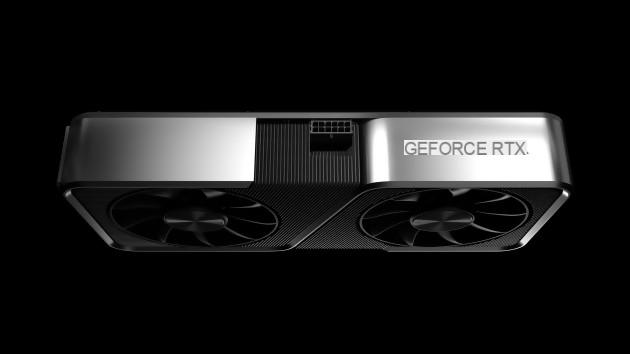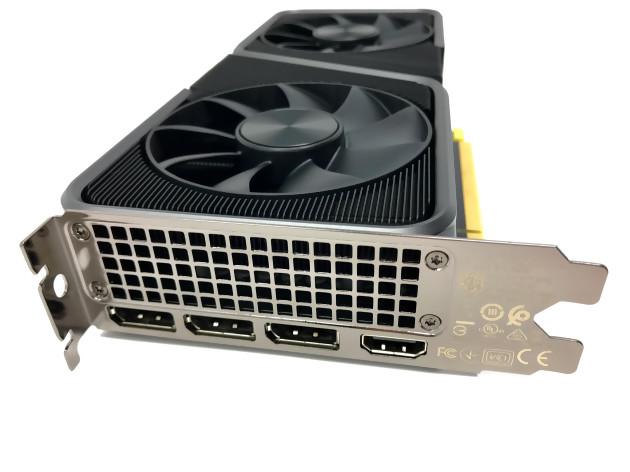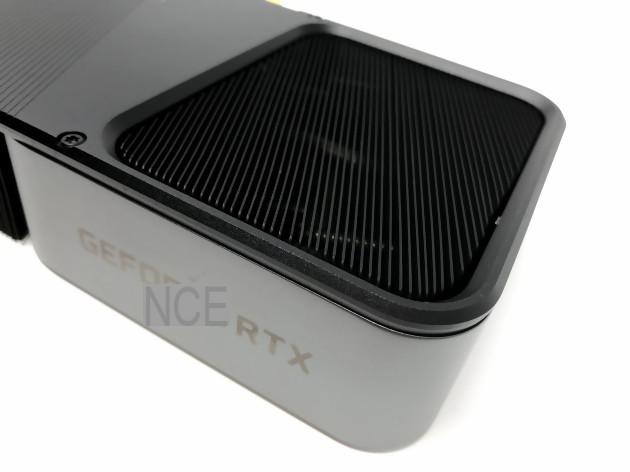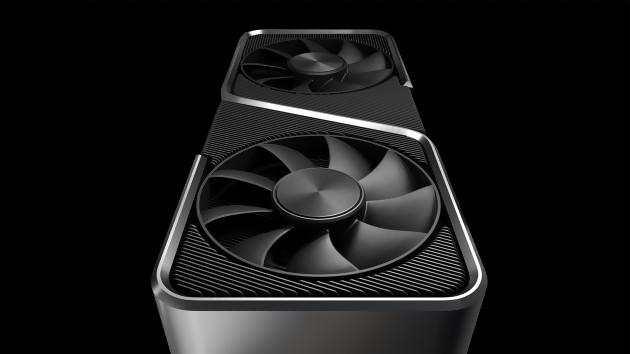Sold by the Santa Clara brand as a card that targets players who love 1440p, this RTX 3070 still has a small advantage up its sleeve. Indeed, the brand has promised us at length in the press release performance equivalent, or even superior, to the RTX 2080 Ti, the most high-end card of the previous generation. The one that had finally made it possible to be able to enjoy 4K without having to cut back on a large number of graphic options. Unsurprisingly, the RTX 3070 does very well at 1440p, and will allow anyone to run most games at full speed, without going below 60fps. But we decided to see if this card also allowed you to take advantage of 4K, without having to invest an excessive budget in your configuration.
On paper, the offer is solid, with a technical sheet that impresses. Indeed, this 3070 integrates 8GB of GDDR6 (a little slower than the GDDR6X of its big sisters), 5888 CUDA cores and can climb to 1773 Mhz in boost. Of course, these figures only concern our Founder's Edition version, as Nvidia's partner assemblers can modify the frequency of the chips in their products at their leisure. Moreover, we will specify that thanks to the GPU Boost, our copy had no trouble reaching 2Ghz on time, before stabilizing at 1994Mhz, while the memory remains stable at 7Ghz. Like all 30 series cards, the 3070 benefits from an 8nm engraving process signed by Samsung, and therefore embeds second-generation Ray-Tracing cores, and third-generation Tensor Cores (those reserved for AI). It is therefore expected that DLSS and RTX will only be a formality for this new GPU. The new fineness of engraving will also greatly improve the density of the transistors, and improve the level of performance per Watts as we will see below.
LESS IS MORE
Aesthetically, the RTX 3070 Founder's Edition is truly a beautiful object. Heavy, assembled with quality materials, this card is smaller than the 3090 and 3080, and has a slightly different cooling system. Indeed, this time, the two fans take place on the same side, even if the famous crossing radiator has been renewed. Indeed, the first propeller brings out the hot air through the back of the case, while the second sends the air upwards, through a rather imposing heat pipe venitrad. Small bonus: when the card is at rest, the fans will remain stopped, so as not to produce noise pollution. As far as connectivity is concerned, the 3070 will not be jealous since it incorporates the equipment of the models already unveiled, with an HDMI 2.1 port and three DisplayPort 1.4a ports. Finally, be aware that the PCIE socket is compatible with the 4.0 standard, even if a motherboard limited to 3.0 will work perfectly, with a loss of performance that oscillates between minimal and negligible. Finally, note that the new mini 12-pin power connector has been carried over to this card, with an adapter that plugs into a classic 8-pin.

We also wonder the reason for this choice, since an 8-pin connector occupies exactly the same space as the mini 12-pin. It remains to be seen what this card is worth in game, and unsurprisingly, the promises made by Nvidia seem very close to reality. Compared to our RTX 2080 Ti, the 3070 displays very similar performance, or even identical when the titles make heavy use of RTX and DLSS. To test this card, we used an affordable configuration with an i7-8700K and 32GB of DDR4, while installing our games on a WD-Black SN2 M.750 SSD.
Mark 3D
Timespy 4K
RTX 2080Ti : 7096 points
RTX 3070 : 6634 points
Port Royal (RTX)
RTX 2080Ti : 9310 points
RTX 3070 : 7929 points
F1 2020 (4K Ultra)
RTX 2080 Ti : 105 FPS
RTX 3070 : 129 FPS
GTA V (4K Ultra)
RTX 2080 Ti : 63 FPS
RTX 3070 : 50 FPS
Shadow of the Tomb Raider (4K RTX DLSS Ultra)
RTX 2080 Ti: 64FPS
RTX 3070 : 56 FPS
DOOM Eternal (4K Ultra Nightmare)
RTX 2080 Ti : 120 FPS
RTX 3070 : 98 FPS
Control (4K RTX + DLSS)
RTX 2080 Ti : 50 FPS
RTX 3070 : 47 FPS
Metro Exodus (4K Extreme DLSS)
RTX 2080 Ti : 48 FPS
RTX 3070 : 45 FPS

With such differences, we can only be impressed by the new card from Nvidia. Yes, the latter remains a few FPS under the RTX 2080 Ti in the context of this 4K use, but it has strong arguments to capsize the hearts of players. Indeed, we have voluntarily chosen to carry out all our tests by pushing the graphics options to the limit. By being more measured, the 4K 60 FPS is therefore well within reach of this RTX 3070. In return for these few FPS difference, the 3070 offers us serious advantages, starting with its power consumption. While our 2080Ti does not hesitate to suck around 330 Watts under load, the 3070 is impressively sober, with only 230 Watts. This saving has other effects, particularly in terms of thermal releases. Again, while the 2080Ti oscillates between 78 and 80°c under full load, the RTX 3070 and its heatsink aesthetics keep the temperature below 68°c.

As everyone knows, lower temperatures guarantee a better longevity of the components, but above all largely contained noise pollution. Finally, the strong argument of this GPU is of course its price, since the RTX 3070 is displayed at 519€. We recall in passing that the RTX 2080Ti (which therefore offers barely higher performance) was displayed at 1259€ when it was released. With this 3070, the Santa Clara firm therefore halves the slate, and risks sticking a lot of remorse to those who bought the best GPU on the market in 2018. The worst thing is that most players who have put their old 2080Ti on auction sites in order to afford a 3080 or a 3090 have chosen to display their card between 600 and 800€. The resale promises to be devilishly difficult.

But then who is this RTX 3070 for? As always, the choice of a new graphics card often depends on financial criteria, especially in this time of crisis. However, if you are a gamer who has a 2 or 4K screen, and you have not yet made the leap into the world of RTX, this 3070 is a perfect argument to drop your old GTX. Better still, with its decent 4K capabilities, this GPU is also a solid choice for those looking to upgrade from 2K to 4K in the coming months. As with all GeForce RTX 30 series, the question will mainly focus on the availability of this RTX 3070. Nvidia claims to have done what it takes to avoid shortages and massive purchases by speculators, it remains to be seen what will happen in reality, since sales will start tomorrow! We obviously advise you to pre-order as soon as possible if you want to have a concrete hope of being able to take advantage of this excellent graphics card with such an attractive price-performance ratio.
TECHNICAL SHEET
| GPU specs: | NVIDIA CUDA® Hearts | 5888 |
| Boost Frequency (GHz) | 1.73 | |
| Base Frequency (GHz) | 1.50 | |
| Memory specifications: | Standard memory configuration | 8 GB GDDR6X |
| Memory interface size | 256-bit | |
| Technologies: | Ray tracing hearts | 2th generation |
| Tensor Cores | 3th generation | |
| Architecture NVIDIA | Ampere | |
| Microsoft DirectX® 12 Ultimate | Yes | |
| NVIDIA DLSS | Yes | |
| PCI Express Gen4 | Yes | |
| NVIDIA® GeForce Experience™ | Yes | |
| NVIDIA Ring | Yes | |
| NVIDIA FreeStyle | Yes | |
| NVIDIA Shadow Play | Yes | |
| NVIDIA highlights | Yes | |
| NVIDIA G-SYNC® | Yes | |
| Pilotes Game Ready | Yes | |
| NVIDIA Studio drivers | Yes | |
| NVIDIA GPU Boost™ | Yes | |
| NVIDIA NVLink™ (SLI-Ready) | - | |
| Vulkan RT API, OpenGL 4.6 | Yes | |
| HDMI 2.1 | Yes | |
| Display Port 1.4a | Yes | |
| NVIDIA encoder | 7th generation | |
| NVIDIA decoder | 5th generation | |
| VR Ready | Yes | |
| Display: | Maximum digital resolution (1) | 7680x4320 |
| Standard display connectors | HDMI 2.1, 3x DisplayPort 1.4a | |
| Multi-screen mode | 4 | |
| HDCP | 2.3 | |
| Dimensions (Founders Edition): | Length | 9,5 "(242 mm) |
| Width | 4.4 "(112 mm) | |
| Height | 2 slot | |
| Thermal/Power Specifications (Founders Edition): | Maximum GPU temperature (°C) | 93 |
| Graphics consumption (Watts) | 220 | |
| Recommended System Power (Watts) (2) | 650 | |
| Additional power connectors | 1x 8 pin PCIe |


























